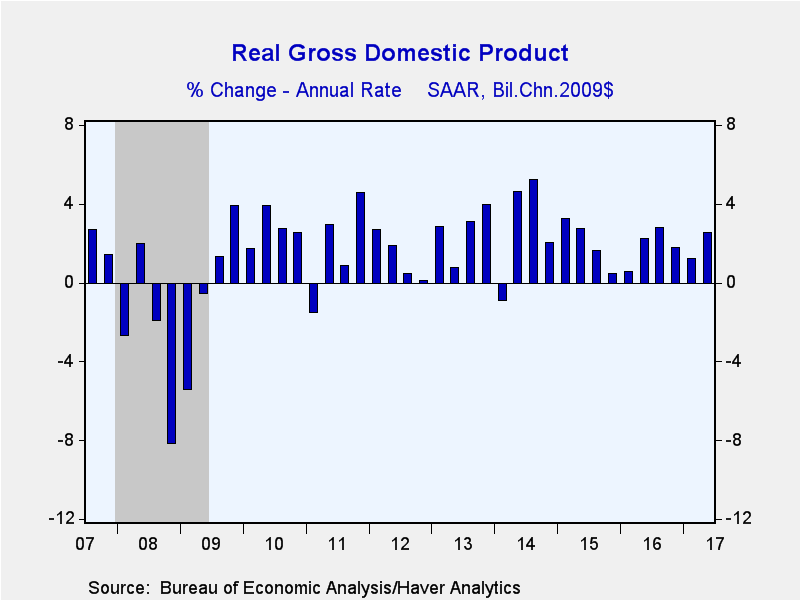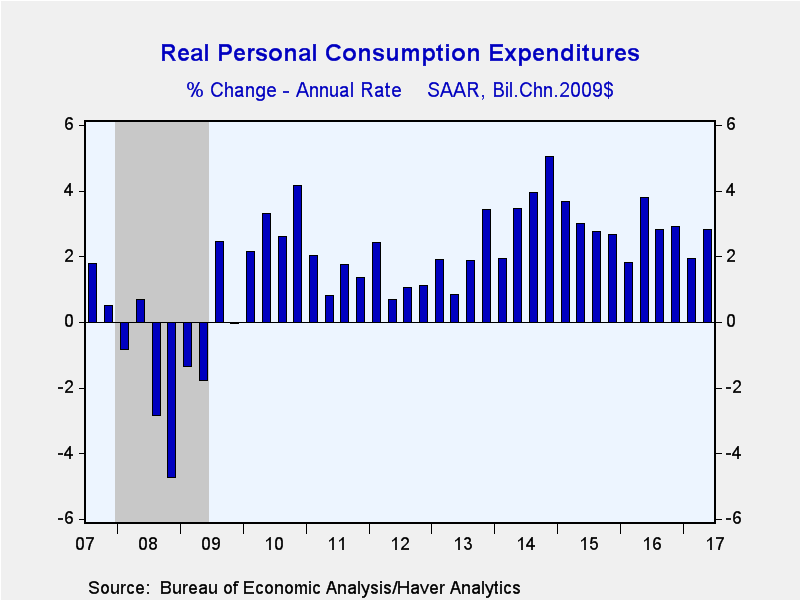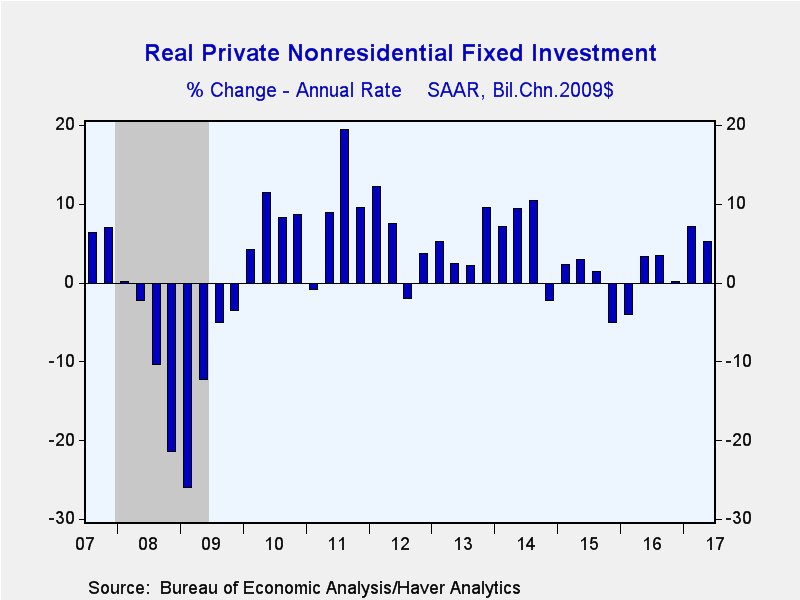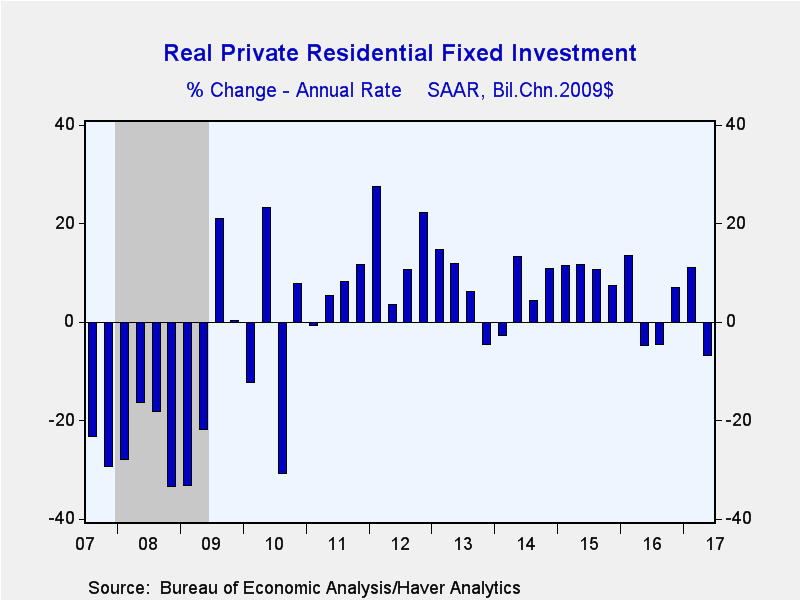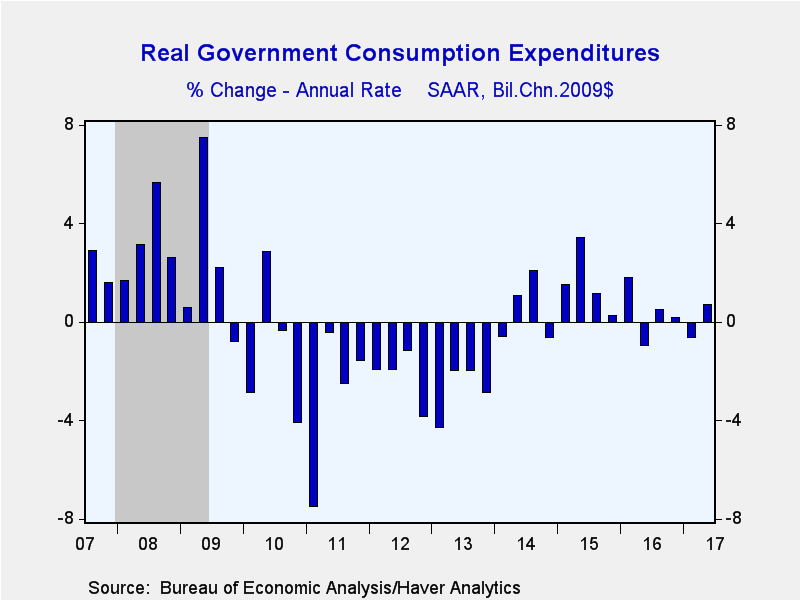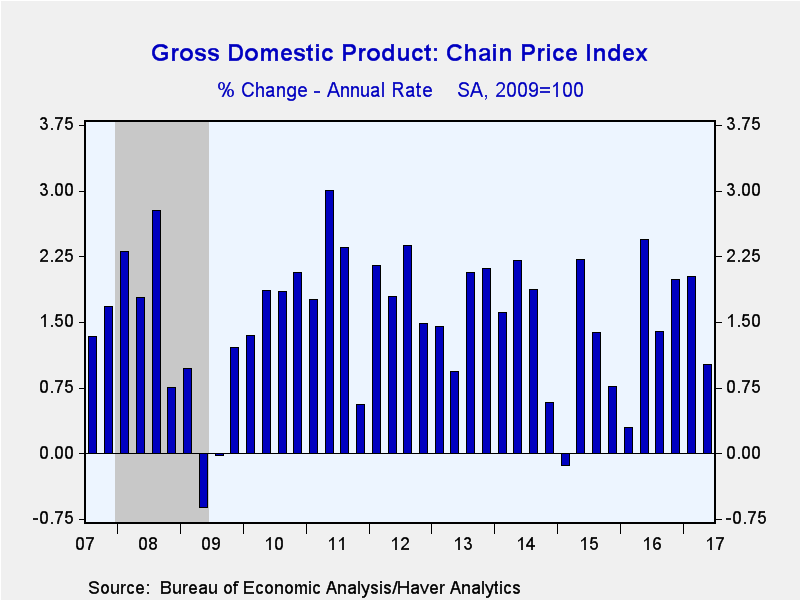 Global| Jul 28 2017
Global| Jul 28 2017U.S. GDP Growth Picks Up as Inventories Firm
by:Tom Moeller
|in:Economy in Brief
Summary
Economic growth accelerated during Q2'17 to 2.6% (2.1% y/y), the quickest advance in three quarters. Real GDP growth during Q1 was revised to 1.2% from 1.4%. Earlier estimates for 2015 and 2014 were revised slightly higher. Growth of [...]
Economic growth accelerated during Q2'17 to 2.6% (2.1% y/y), the quickest advance in three quarters. Real GDP growth during Q1 was revised to 1.2% from 1.4%. Earlier estimates for 2015 and 2014 were revised slightly higher. Growth of 2.5% had been expected in the Action Economics Forecast Survey.
An absence of inventory decumulation accounted for the acceleration in growth. Inventory change had no effect on growth after decumulation subtracted 1.5 percentage points in Q1'17 and subtracted 0.4 percentage points during all of last year. Improvement in the foreign trade deficit added 0.2 percentage points to growth, as it did during Q1. Exports grew 4.1% (3.4% y/y) and imports rose 2.1% (4.2% y/y).
Growth in domestic final demand held steady with Q1 at 2.4% (2.3% y/y). Consumer spending growth accelerated to 2.8% as durable goods purchases rebounded 6.3% (6.1% y/y) after a 0.1% dip. Home furnishings & appliance purchases nearly doubled to 8.1% (6.0% y/y) while recreational goods & vehicles buying strengthened 13.4% (10.8% y/y) following a 10.6% rise. The decline in motor vehicles & parts purchases lessened to 1.8% (+3.7% y/y) from -9.6%. Nondurable goods purchases grew 3.8% (1.9% y/y) following a 1.1% rise. Apparel purchases rebounded 9.3% (2.0% y/y) following a 3.7% decline. Gasoline & energy product buying grew 5.7% (-1.4% y/y) and fully reversed the Q1 drop. Weakening was the gain in spending on services which decelerated to 1.9% (2.3% y/y) from 2.5%. Recreation spending declined 0.6% (+2.8% y/y) after a 4.4% rise and restaurant & hotel spending fell 1.5% (+0.7% y/y) following a 2.6% improvement. This weakness was offset by housing & utilities expenditures which rose 2.8% (0.9% y/y) after a 0.4% dip plus accelerated health care spending growth of 3.0% (2.9% y/y).
Business fixed investment growth of 5.2% (3.9% y/y) compared to 7.1% growth in the prior quarter. Equipment growth nearly doubled to 8.2% (3.0% y/y) as information processing equipment buying rose 12.3% (7.4% y/y) following an 8.1% rise. Spending on intellectual property products offset this improvement with a deceleration to 1.4% (2.7% y/y) from 5.8%. Spending growth on software decelerated to 7.2% from 17.2%.
Residential investment declined at a 6.8% rate (+1.4% y/y) following an 11.1% gain.
Government spending growth improved 0.7% (0.2% y/y) following a 0.6% decline. Federal government spending reversed its Q1 decline with a 2.3% rise (0.2% y/y). Defense spending jumped 5.2% (0.2% and continued a volatile q/q growth pattern. State & local spending eased 0.2% (+0.2% y/y) after a 0.5% rise.
The GDP price index grew 1.0% (1.6% y/y) following two quarters of 2.0% gain. A 1.4% rise had been expected. The PCE price index improved just 0.3% (1.6% y/y) after a 2.2% rise. The gain was held back by a 3.4% decline in durable goods prices, down 2.3% y/y. Nondurable goods prices also weakened 3.6% (+1.1% y/y) as prices for gasoline and other energy products fell. Services prices improved 2.1% (2.3% y/y). The business fixed investment price index rose 2.4% (1.7% y/y), but growth in the residential investment price index accelerated to 4.1% (4.2% y/y).
The GDP figures can be found in Haver's USECON and USNA database. USNA contains virtually all of the Bureau of Economic Analysis' detail in the national accounts, including the integrated economic accounts and the recently added GDP data for U.S. Territories. The Action Economics consensus estimates can be found in AS1REPNA.
Tom Moeller
AuthorMore in Author Profile »Prior to joining Haver Analytics in 2000, Mr. Moeller worked as the Economist at Chancellor Capital Management from 1985 to 1999. There, he developed comprehensive economic forecasts and interpreted economic data for equity and fixed income portfolio managers. Also at Chancellor, Mr. Moeller worked as an equity analyst and was responsible for researching and rating companies in the economically sensitive automobile and housing industries for investment in Chancellor’s equity portfolio. Prior to joining Chancellor, Mr. Moeller was an Economist at Citibank from 1979 to 1984. He also analyzed pricing behavior in the metals industry for the Council on Wage and Price Stability in Washington, D.C. In 1999, Mr. Moeller received the award for most accurate forecast from the Forecasters' Club of New York. From 1990 to 1992 he was President of the New York Association for Business Economists. Mr. Moeller earned an M.B.A. in Finance from Fordham University, where he graduated in 1987. He holds a Bachelor of Arts in Economics from George Washington University.


